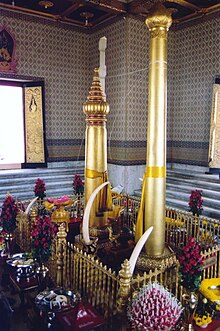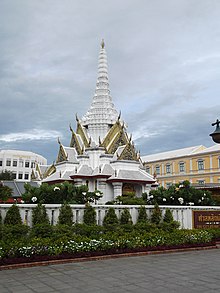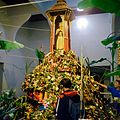ศาลหลักเมืองกรุงเทพมหานคร ถนนหลักเมือง แขวงพระบรมมหาราชวัง เขตพระนคร กรุงเทพมหานคร.
Lak Muang City Pillar, Bangkok, Thailand.
Photo Gallery. Asian Historical Architecture.
ขอบคุณ ภาพและข้อมูล จาก http://www.orientalarchitecture.com/sid/608/thailand/bangkok/lak-muang-city-pillar
Lak Muang City Pillar (หลักเมือง) (built 1782)
This is the pillar that was set up by the king in 1782 when Bangkok became the capital of Siam. The pillar houses the spirit of the city and there are a stream of worshippers there offering flower, incense, fruit, candles, burning oil, etc. Some even pay the resident dancers to perform as a form of thanks when they have good luck.
Location
The approximate location of the site is 13.752846' N, 100.494209' E (WGS 84 map datum).
ศาลหลักเมือง. The City Pillar Shrine.
ศาลหลักเมืองกรุงเทพมหานคร ถนนหลักเมือง แขวงพระบรมมหาราชวัง เขตพระนคร กรุงเทพมหานคร.
02.Lak Muang City Pillar, Bangkok, Thailand.Photo Gallery. Asian Historical Architecture.
ศาลหลักเมืองกรุงเทพมหานคร ถนนหลักเมือง แขวงพระบรมมหาราชวัง เขตพระนคร กรุงเทพมหานคร.
03.Lak Muang City Pillar, Bangkok, Thailand.Photo Gallery. Asian Historical Architecture.
ศาลหลักเมืองกรุงเทพมหานคร ถนนหลักเมือง แขวงพระบรมมหาราชวัง เขตพระนคร กรุงเทพมหานคร.
04.Lak Muang City Pillar, Bangkok, Thailand.Photo Gallery. Asian Historical Architecture.
ศาลหลักเมืองกรุงเทพมหานคร ถนนหลักเมือง แขวงพระบรมมหาราชวัง เขตพระนคร กรุงเทพมหานคร.
05.Lak Muang City Pillar, Bangkok, Thailand.Photo Gallery. Asian Historical Architecture.
ศาลหลักเมืองกรุงเทพมหานคร ถนนหลักเมือง แขวงพระบรมมหาราชวัง เขตพระนคร กรุงเทพมหานคร.
06.Lak Muang City Pillar, Bangkok, Thailand.Photo Gallery. Asian Historical Architecture.
ศาลหลักเมืองกรุงเทพมหานคร ถนนหลักเมือง แขวงพระบรมมหาราชวัง เขตพระนคร กรุงเทพมหานคร.
07.Lak Muang City Pillar, Bangkok, Thailand.Photo Gallery. Asian Historical Architecture.
ศาลหลักเมืองกรุงเทพมหานคร ถนนหลักเมือง แขวงพระบรมมหาราชวัง เขตพระนคร กรุงเทพมหานคร.
08.Lak Muang City Pillar, Bangkok, Thailand.Photo Gallery. Asian Historical Architecture.
ศาลหลักเมืองกรุงเทพมหานคร ถนนหลักเมือง แขวงพระบรมมหาราชวัง เขตพระนคร กรุงเทพมหานคร.
09.Lak Muang City Pillar, Bangkok, Thailand.Photo Gallery. Asian Historical Architecture.
ศาลหลักเมืองกรุงเทพมหานคร ถนนหลักเมือง แขวงพระบรมมหาราชวัง เขตพระนคร กรุงเทพมหานคร.
10.Lak Muang City Pillar, Bangkok, Thailand.Photo Gallery. Asian Historical Architecture.
ศาลหลักเมืองกรุงเทพมหานคร ถนนหลักเมือง แขวงพระบรมมหาราชวัง เขตพระนคร กรุงเทพมหานคร.
11.Lak Muang City Pillar, Bangkok, Thailand.Photo Gallery. Asian Historical Architecture.
ศาลหลักเมืองกรุงเทพมหานคร ถนนหลักเมือง แขวงพระบรมมหาราชวัง เขตพระนคร กรุงเทพมหานคร.
12.Lak Muang City Pillar, Bangkok, Thailand.Photo Gallery. Asian Historical Architecture.
ศาลหลักเมืองกรุงเทพมหานคร ถนนหลักเมือง แขวงพระบรมมหาราชวัง เขตพระนคร กรุงเทพมหานคร.
13.Lak Muang City Pillar, Bangkok, Thailand.Photo Gallery. Asian Historical Architecture.
ศาลหลักเมืองกรุงเทพมหานคร ถนนหลักเมือง แขวงพระบรมมหาราชวัง เขตพระนคร กรุงเทพมหานคร.Lak Muang City Pillar, Bangkok, Thailand.
Photo Gallery. Asian Historical Architecture.
ขอบคุณ ภาพและข้อมูล จาก http://www.orientalarchitecture.com/sid/608/thailand/bangkok/lak-muang-city-pillar
-----------------------------------------------------
ขอบคุณ ข้อมูลและภาพ จาก https://en.wikipedia.org/wiki/Lak_Mueang
Lak Mueang
From Wikipedia, the free encyclopedia
Lak mueang (Thai: หลักเมือง) are city pillars found in most cities of Thailand. Usually housed in a shrine (Thai: ศาลหลักเมือง) which is also believed to house Chao Pho Lak Mueang (เจ้าพ่อหลักเมือง), the city spirit deity. It was constructed because the continuation of ancient traditions and Brahman's customs believed that it has something to do with the Held, the single city pillar ceremony (Held “Lak Muang”) which is made of an Acacia wood Chaiyaphreuk (Thai: ชัยพฤกษ์) before the construction of the city for a major goal to build a city and to be the centre of soul for the citizens.
It was probably King Rama I who erected the first city pillar on 21 April 1782, when he moved his capital from Thonburi to Bangkok. The shrine was the first building in his new capital, the palace and other buildings being constructed later.
Contents
[hide]Outside Bangkok[edit]
Shortly after the shrine in Bangkok, similar shrines were built in strategic provinces to symbolise central power, such as in Songkhla. More shrines were created during the reign of King Buddha Loetla Nabhalai (Rama II) in Nakhon Khuen Khan and Samut Prakan, and by King Nangklao(Rama III) in Chachoengsao, Chanthaburi, and Phra Tabong Province (now in Cambodia). However, after King Mongkut raised a new pillar in Bangkok, no further shrines in the provinces were built until 1944, when then-Prime Minister of Thailand Phibunsongkhram built a city pillar in Phetchabun, as he intended to move the capital to this town. Though this plan failed to get approval by the parliament, the idea of city pillars caught on, and in the following years several provincial towns built new shrines. In 1992, the Ministry of Interior ordered that every province should have such a shrine. As of 2010, however, a few provinces still have no city pillar shrine. In Chonburi the shrine was scheduled to be finished by the end of 2011.[1][2]
The building style of the shrines varies. Especially in provinces with a significant Thai Chinese influence, the city pillar may be housed in a shrine that resembles a Chinese temple as, for example in Songkhla, Samut Prakan, and Yasothon. Chiang Rai's city pillar is not housed in a shrine at all; but, since 1988, is in an open place inside Wat Phra That Doi Chom Thong; it is called the sadue mueang (Thai: สะดือเมือง), navel or omphalos of the city. In Roi Et, the city pillar is housed in a sala(open-air pavilion) on an island in the lake in the centre of the city.
The Bangkok city pillar shrine[edit]
Bangkok's city pillar shrine (also known as san lak muang) is one of the most ancient, sacred, and magnificent city pillar shrines in Thailand. It was believed that people would achieve prosperity and fulfillment in their work and career, avoid misfortune, and improve their luck, power, and prestige if they took a bow and paid their respects at this sacred place. The shrine is in the heart of Bangkok, opposite the grand palace in the southeast corner of the Sanam Luang and close to the Ministry of Defence. According to a historian, the shrine was built after the establishment of the Rattanakosin Kingdom (Bangkok) to replace the old capital of the Thonburi Kingdom during the reign of King Rama I of the Chakri Dynasty at 06:45, Sunday, 21 April 1782. It was constructed according to ancient traditions such as the brahmans' belief in the held, the single city pillar ceremony (held "lak muang"), in which a pillar of acacia wood (chaiyapreuk) was erected before the effort of constructing the city began. It was intended to be the spiritual centre for Thai citizens.[citation needed]
"Chaiyapreuk" (acacia) means "tree of victory". This wood was used by Thai locals to build a pillar 270 centimetres (110 in) high, buried 200 centimetres (79 in) deep, making a total height of 470 centimetres (190 in), and 74 centimetres (29 in) in diameter. Inside was a horoscope for Bangkok. However, the shrine was renovated several times during the reigns of Kings Rama IV and Mongkut, and then became dilapidated. The king therefore ordered the excavation of the old pillar and construction of a replacement, with a new horoscope for the city placed inside. In 1852 the new pillar was installed, measuring 5.115 metres (201.4 in) tall, 47 centimetres (18.8 in) in diameter at the bottom, with a base 180 centimetres (71 in) wide. Both old and new pillars were moved to a refurbished pavilion with a spire (prang) modelled on the shrine of Ayudhya. The shrine was finished on Sunday, 1 May 1853. In 1980, in preparation for the celebration of the 200th anniversary of Rattanakosin in 1982, the Bangkok city pillar shrine underwent renovation, including the addition of arches to house a five-city guardian deity.[citation needed]
According to the In–Chan–Mun–Kong legend of the shrine, Thai locals believed that the construction of the shrine required the sacrifice of four people after the proclamation of the words "in–chan–mun–kong" all over the city ("in" from the north, "chan"from the south, "mun" from the east, and "kong" from the west). Anyone who responded was captured, brought to the ceremonial location, and buried in a hole. Their spirits would guard and protect the city. This is only a myth and is not recorded in the chronicles.[citation needed]
People usually use three incense sticks, one candle, gold foil, two lotuses, two flower garlands, and one three-colour taffeta to worship at the shrine.
Gallery[edit]
See also
----------------------------------------------------
ขอบคุณ ข้อมูลและภาพ จาก https://th.wikipedia.org/wiki/ศาลหลักเมืองกรุงเทพมหานคร
ศาลหลักเมืองกรุงเทพมหานคร
จากวิกิพีเดีย สารานุกรมเสรี
| ศาลหลักเมืองกรุงเทพมหานคร | |
|---|---|
| Bangkok City Pillar Shrine | |

ศาลหลักเมืองกรุงเทพมหานคร
| |
| ข้อมูลทั่วไป | |
| ประเภท | ศาลหลักเมือง |
| ที่ตั้ง | ถนนหลักเมือง แขวงพระบรมมหาราชวัง เขตพระนคร กรุงเทพมหานคร |
| ประเทศ | |
| การก่อสร้าง | |
| ปีสร้าง | 21 เมษายน พ.ศ. 2325[1] |
| ผู้สร้าง | พระบาทสมเด็จพระพุทธยอดฟ้าจุฬาโลกมหาราช (วางเฉพาะเสา) |
| ปีบูรณะ | พ.ศ. 2395[2] พ.ศ. 2525 - 2529 |
| ผู้บูรณะ | พระบาทสมเด็จพระจอมเกล้าเจ้าอยู่หัว(วางเสาใหม่อีกต้น) |
| สถาปัตยกรรม | สถาปัตยกรรมขอม สถาปัตยกรรมไทย |
| ผู้ออกแบบ/ตกแต่ง | |
| สถาปนิก | พล.อ.ต. อาวุธ เงินชูกลิ่น (ศาลาทรงขอมตามภาพ)[3] |
| ข้อมูลด้านการท่องเที่ยว | |
| สิ่งที่น่าสนใจ | เป็นสถานที่ที่ก่อตั้งควบคู่กับการสถาปนานากรุงรัตนโกสินทร์ |
ศาลหลักเมืองกรุงเทพมหานคร เป็นศาลที่สร้างขึ้นมาพร้อมกับการสถาปนากรุงรัตนโกสินทร์เป็นราชธานี ตามธรรมเนียมพิธีพราหมณ์ว่า ก่อนที่จะสร้างเมืองจะต้องทำพิธียกเสาหลักเมืองในที่อันเป็นชัยภูมิสำคัญ เพื่อเป็นสิริมงคลแก่บ้านเมืองที่จะสร้างขึ้น ศาลหลักเมืองกรุงเทพมหานครตั้งอยู่บริเวณมุมด้านทิศตะวันออกเฉียงใต้ของท้องสนามหลวง ตรงข้ามพระบรมมหาราชวังถนนหลักเมือง แขวงพระบรมมหาราชวัง เขตพระนคร กรุงเทพมหานคร
จุดสำคัญของศาลหลักเมืองคือ เสาหลักเมือง ซึ่งได้กระทำพิธียกเสาขึ้นเมื่อวันที่ 21 เมษายน พ.ศ. 2325 เดิมทีเสาหลักเมือง มีเพียงศาลาปลูกไว้กลางแดดกันฝนเท่านั้น จนชำรุดลงอย่างมากในสมัยรัชกาลที่ 4 จึงโปรดเกล้าฯให้ทำขึ้นใหม่อีกเสาหนึ่ง ด้วยเหตุนี้เองจึงทำให้ศาลหลักเมืองกรุงเทพมหานครมีเสาหลักเมือง 2 ต้น นับจากนั้นเป็นต้นมา
สำหรับศาลาศาลหลักเมืองหลังปัจจุบันนี้ มีรูปแบบเป็นอาคารเครื่องปูน ทรงยอดปรางค์ มีมุขยื่นทั้ง 4 ด้าน แต่ละด้านมีหลังคาซ้อน 2 ชั้น และมีมุขลดอีกด้านละ 1 ชั้น มีหลังคากันสาดโดยรอบ เครื่องมุงประดับกระเบื้องเคลือบ ตามลักษณะสถาปัตยกรรมอยุธยาในอดีต ได้รับการออกแบบโดย พล.อ.ต. อาวุธ เงินชูกลิ่น (ศิลปินแห่งชาติสาขาศิลปะสถาปัตยกรรม ในเวลาต่อมา) พระบาทสมเด็จพระปรมินทรมหาภูมิพลอดุลยเดช มีพระบรมราชวินิจฉัยในงานออกแบบครั้งนี้ด้วย[4][3]
ประวัติ[แก้]
พระบาทสมเด็จพระพุทธยอดฟ้าจุฬาโลกมหาราช รัชกาลที่ 1 ได้โปรดเกล้าให้กระทำพิธียกเสาหลักเมือง เมื่อวันอาทิตย์ เดือน 6 ขึ้น 10 ค่ำ ตรงกับวันที่ 21 เมษายน พ.ศ. 2325 เวลา 6.54 นาฬิกา การฝังเสาหลักเมืองมีพิธีรีตองตามพระตำราที่เรียกว่า พระราชพิธีนครฐาน ใช้ไม้ชัยพฤกษ์ทำเป็นเสาหลักเมือง ประกับด้านนอกด้วยไม้แก่นจันทน์ที่มี เส้นผ่าศูนย์กลางวัดที่โคนเสา 29 เซนติเมตร สูง 187 นิ้ว กำหนดให้ความสูงของเสาหลักเมืองอยู่พ้นดิน 108 นิ้ว ฝังลงในดินลึก 79 นิ้ว มีเม็ดยอดรูปบัวตูม สวมลงบนเสาหลัก ลงรักปิดทอง ล้วงภายในไว้เป็นช่องสำหรับบรรจุดวงชะตาเมือง
ในรัชสมัยพระบาทสมเด็จพระจอมเกล้าเจ้าอยู่หัว รัชกาลที่ 4 โปรดเกล้าให้ขุดเสาหลักเมืองเดิม และจัดสร้างเสาหลักเมืองขึ้นใหม่ทดแทนของเดิมที่ชำรุด เป็นแกนไม้สัก ประกับนอกด้วยไม้ชัยพฤกษ์ 6 แผ่น สูง 108 นิ้ว ฐานเป็นแท่นกว้าง 70 นิ้ว บรรจุดวงเมืองในยอดเสาทรงมัณฑ์ที่มีความสูงกว่า 5 เมตร และอัญเชิญหลักเมืองเดิม และหลักเมืองใหม่ ประดิษฐานในอาคารศาลหลักเมืองที่สร้างใหม่ มียอดปรางค์ ก่ออิฐฉาบปูนขาว ได้แบบอย่างจากศาลหลักเมืองกรุงศรีอยุธยา เมื่อปีพุทธศักราช 2395
ศาลหลักเมืองได้รับการปฏิสังขรณ์อีกหลายครั้ง ในปี พ.ศ. 2523 มีการบูรณะซ่อมแซมครั้งใหญ่ เพื่อเตรียมการเฉลิมฉลองสมโภชกรุงรัตนโกสินทร์ ครบ 200 ปี พ.ศ. 2525 ศาลหลักเมืองได้รับการบูรณะอย่างสวยงาม ด้านทิศเหนือจัดสร้างซุ้มสำหรับประดิษฐานเทพารักษ์ทั้ง 5 คือเจ้าพ่อหอกลอง เจ้าพ่อเจตคุปต์ พระเสื้อเมือง พระทรงเมือง และพระกาฬไชยศรี มีการจัดละครรำ ละครชาตรี ให้ผู้ต้องการบูชา ว่าจ้างรำบูชาศาลหลักเมืองอยู่ด้านข้าง
อ้างอิง[แก้]
- ↑ ศาลหลักเมือง กรุงเทพมหานคร, ศูนย์ข้อมูลเกาะรัตนโกสินทร์ .สืบค้นเมื่อ 15/12/2559
- ↑ เหตุใด "เสาหลักเมือง" กรุงเทพมหานคร จึงมีสองต้น, pisit site .สืบค้นเมื่อ 15/12/2559
- ↑ 3.0 3.1 ศาลหลักเมือง กรุงเทพมหานคร (พ.ศ. ๒๕๒๕ – ๒๕๒๙), ArtBangkok .สืบค้นเมื่อ 15/12/2559
--------------------------------------------------
ขอบคุณ ข้อมูลและภาพ จาก http://thaprajan.blogspot.com/2011/04/blog-post.html
---------------------------------------------------------------------------------------------------































ไม่มีความคิดเห็น:
แสดงความคิดเห็น